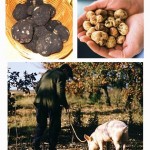Matilde of Canossa,Countess of Tuscany, also called “the Church -builder”, was the most influential woman of her time(1046-1115), and probably of any time. She was the sole survivor of a powerful Longobard family.
At the age of 8 she inherited from her father Maurquis Bonifacio 3 vast amounts of Lombardy and Emilia. Her mother was Beatricie of Lorraine ,daughter of Frideryk II Duke uof Upper Lorraine and granddaughter of Herman 2 of Swabia.
Matilde may have been born in Mantua ,but since her father had castle and country home at Vivinaja (now Montecarlo ),this is also considered a likely birthplace for Her. Her fathers home at Vivinaja was a gathering place for the popes and emperors, in this period when Lucca was the Tuscan capital. Matilde had a aristocratic education; she spoke German, Latin and French. She learned to ride horses and use weapons.
Matildes first marriage was to a pious man with the uninspiring name of Godfrey the Hunchback, who allegedly died in the Crusades. Later (in 1090 ,when she was 54), she got married for political motives to a younger man, Welf Guelfo of Bavaria.
It is uncertain whether Matildes one child from her first marriage, Beatricie, survived past childhood. Matilde may have been the last for her line. However, Michelangelo claimed to be her Descendent…..This is hearsay. Matildes most potent legancy was spirityal and political.
Matilde wanted to become a nun to celebrate the mass.
This latter is a radical idea even today! According to legend Pope Gregory told her to build 100 churches and then he would consider her request. (For the of her story ,see Andy*rindls book A Compation to Lucca.) Instead he gave her authority over all of Tuscany.
She become a military heroine,deeply loyal to the Pope during the Guelply-Ghibelline conflict, when the Holy Roman Emperor wanted to assume spiritual us well as earthly authority. He ally in Lucca was Bishop Anselmo. Togheter they gave enormous wealth to the Roman church.
They tried to push back the churchs enemies, but Bishop Anselmo was forced to retreat to canossa ,near near Reggioin Emilia. In Lucca she commissioned the spectacular Ponte della Maddalena, now more commonalty known as the Devils Bridge, acros the Serchio. Anselmo become to Canossa a Benedictine monk and come to Canossa as Matilde s spiritual advisor.
He died in 1086 ,ten years after one of historys key events, an event whith sealed Matildes name in history.
In 1077,excommunicated Holy Roman Emperor Henry 4 was advancing agains Pope Gregory,who then staying at matildes castle. But Henry had sufferen huge losses. At the bottom of the hill leading up to the castle, henry knelt in the snow as a barefoot penintent and begged for-giveness, recognizing Papal authority.
Since then, the expression “going to Canossa” has come to mean eating humble pie. Pirandellos play Enrico 4, inspired by this historical moment, empha-sizes Henrys madnes, re-interpreting the story in a modern context, with Matilde in the role of Henrys wife.
Dantes Paradiso, on the other hand,finds Matilde singing, gathering flowers and moving like a dancer in the lower circle of Paradise. She helps him undergo the penitential cleansing required after loss of innocence by having him taste the rivers Lethe and Eunoe (meaning “good memory”in Greek) which flow in opposite direcions from the Earthly Paradise and represent forgetting and remembering.
After this phase of death and regeneration ,he can then meet his final Guide and Patron, Beatricie.
Dante leaves behind all the bleak characters from his pass, immortalized and entrapped in Inferno and Purgatorio.
Dantes vision of Matilde might have influenced Shakespeare in Hamlet. OPhelia tries to lead Hamlet out of his madness with her innocence and love ,but he remains fixated on avenging his fathers ghost. Hamlets words recall historical Matildes wish: “Get thee to a nunnery” — though he adds “why wouldest thou be a breeder of sinners.?” Later Queen Gertrude rapport’s Ophelia, enveloped in Hamlets madness, dies as a young virgin. Matilde, one of Italys most powerful and evocative woman lives on the legend and literature. She died at the age of 69 years, after a long and fascinating life.











